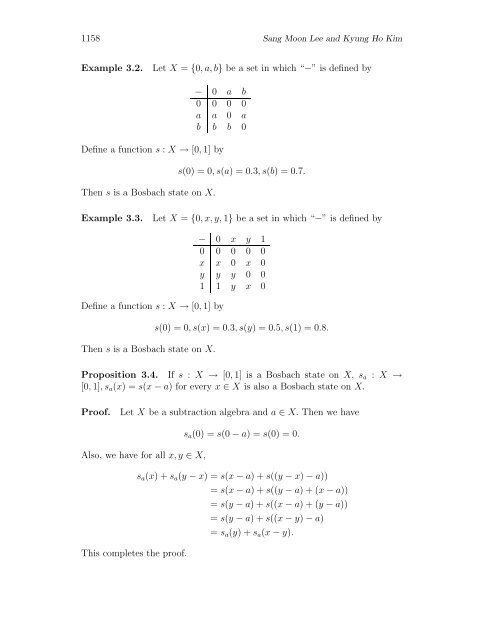States on Subtraction Algebras 1 Introduction
States on Subtraction Algebras 1 Introduction
States on Subtraction Algebras 1 Introduction
You also want an ePaper? Increase the reach of your titles
YUMPU automatically turns print PDFs into web optimized ePapers that Google loves.
1158 Sang Mo<strong>on</strong> Lee and Kyung Ho Kim<br />
Example 3.2.<br />
Let X = {0,a,b} be a set in which “−” is defined by<br />
− 0 a b<br />
0 0 0 0<br />
a a 0 a<br />
b b b 0<br />
Define a functi<strong>on</strong> s : X → [0, 1] by<br />
Then s is a Bosbach state <strong>on</strong> X.<br />
s(0) = 0,s(a) =0.3,s(b) =0.7.<br />
Example 3.3.<br />
Let X = {0,x,y,1} be a set in which “−” is defined by<br />
Define a functi<strong>on</strong> s : X → [0, 1] by<br />
Then s is a Bosbach state <strong>on</strong> X.<br />
− 0 x y 1<br />
0 0 0 0 0<br />
x x 0 x 0<br />
y y y 0 0<br />
1 1 y x 0<br />
s(0) = 0,s(x) =0.3,s(y) =0.5,s(1) = 0.8.<br />
Propositi<strong>on</strong> 3.4. If s : X → [0, 1] is a Bosbach state <strong>on</strong> X, s a : X →<br />
[0, 1],s a (x) =s(x − a) for every x ∈ X is also a Bosbach state <strong>on</strong> X.<br />
Proof.<br />
Let X be a subtracti<strong>on</strong> algebra and a ∈ X. Then we have<br />
s a (0) = s(0 − a) =s(0) = 0.<br />
Also, we have for all x, y ∈ X,<br />
s a (x)+s a (y − x) =s(x − a)+s((y − x) − a))<br />
= s(x − a)+s((y − a)+(x − a))<br />
= s(y − a)+s((x − a)+(y − a))<br />
= s(y − a)+s((x − y) − a)<br />
= s a (y)+s a (x − y).<br />
This completes the proof.
















